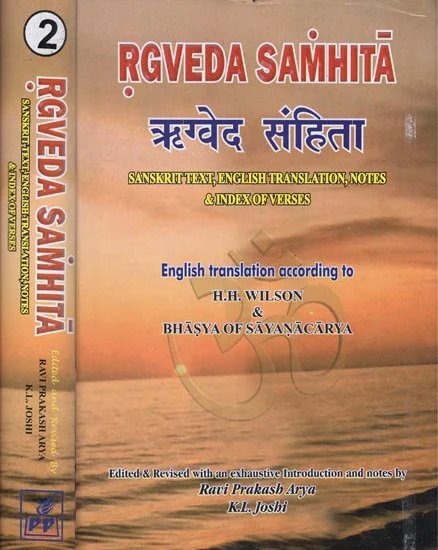Rig Veda (translation and commentary)
by H. H. Wilson | 1866 | 1,999,864 words | ISBN-10: 8171101380 | ISBN-13: 9788171101382
The Rig-Veda, English translation, including the commentary of Sayana and grammatical analysis. The hyms of the Rigveda Samhita represents some of the oldest and complex of Hindu Sanskrit literature. In ten books, these mantras form the core essence of rituals and ceremonies once widely performed throughout ancient India. This edition contains the...
Disclaimer: These are translations of Sanskrit texts and are not necessarily approved by everyone associated with the traditions connected to these texts. Consult the source and original scripture in case of doubt.
Rig Veda 8.102.14
Sanskrit text [Accents, Plain, Transliterated]:
यस्य॑ त्रि॒धात्ववृ॑तं ब॒र्हिस्त॒स्थावसं॑दिनम् । आप॑श्चि॒न्नि द॑धा प॒दम् ॥
यस्य त्रिधात्ववृतं बर्हिस्तस्थावसंदिनम् । आपश्चिन्नि दधा पदम् ॥
yasya tridhātv avṛtam barhis tasthāv asaṃdinam | āpaś cin ni dadhā padam ||
English translation:
“The waters find their plural ce in him, for whom the triple-jointed grass is spread unlimited and untied (inthe sacrifice).”
Commentary by Sāyaṇa: Ṛgveda-bhāṣya
Waters find their plural ce in him: waters rest in Agni, who abides as lightning in the firmament;triple- jointed grass: tridhātu = triparvan; sacred grass is not tied in bundles in the sacrifice;
Tridhātu = threeelements
Details:
Ṛṣi (sage/seer): prayogo bhārgava agnirvā pāvako bārhaspatyaḥ ; athavāgnī gṛhapatiyaviṣṭhau sahasaḥ sutau tayorvānyataraḥ [prayoga bhārgava agnirvā pāvaka bārhaspatya ; athavāgnī gṛhapatiyaviṣṭhau sahasa sutau tayorvānyatara];Devatā (deity/subject-matter): agniḥ ;
Chandas (meter): nicṛdgāyatrī ;
Svara (tone/note): Swar;
Padapatha [Accents, Plain, Transliterated]:
यस्य॑ । त्रि॒ऽधातु॑ । अवृ॑तम् । ब॒र्हिः । त॒स्थौ । अस॑म्ऽदिनम् । आपः॑ । चि॒त् । नि । द॒ध॒ । प॒दम् ॥
यस्य । त्रिधातु । अवृतम् । बर्हिः । तस्थौ । असम्दिनम् । आपः । चित् । नि । दध । पदम् ॥
yasya | tri-dhātu | avṛtam | barhiḥ | tasthau | asam-dinam | āpaḥ | cit | ni | dadha | padam
Multi-layer Annotation of the Ṛgveda
[Rigveda 8.102.14 English analysis of grammar]
[noun], genitive, singular, masculine
“who; which; yat [pronoun].”
[noun]
“three; tri/tisṛ [word].”
[noun], nominative, singular, neuter
“mineral; dhātu; saptadhātu; Sanskrit verbal root; etymon; aṣṭaloha; mahābhūta; gairika; component; navadhātu; svarṇamākṣika; doṣa; inorganic compound.”
[adverb]
“not; akāra; a [taddhita]; a [word]; a; a.”
[verb noun], nominative, singular
“surround; accompany; cover; cover; obstruct; check; spread; envelop.”
[noun], nominative, singular, neuter
“Barhis; barhis [word].”
[verb], singular, Perfect indicative
“stay; stand; situate; exist; [in]; resist; endure; put; soak; be; stop; adhere; get stale; concentrate; grow; trust; wake; consociate; last; dwell; lie; stand; stop.”
[adverb]
“not; akāra; a [taddhita]; a [word]; a; a.”
[verb noun], nominative, singular
[noun], nominative, plural, feminine
“water; body of water; water; ap [word]; juice; jala.”
[adverb]
“even; indeed.”
[adverb]
“back; down.”
[verb], plural, Perfect indicative
“put; give; cause; get; hold; make; provide; lend; wear; install; have; enter (a state); supply; hold; take; show.”
[noun], accusative, singular, neuter
“word; location; foot; footprint; pada [word]; verse; footstep; metrical foot; situation; dwelling; state; step; mark; position; trace; construction; animal foot; way; moment; social station; topographic point; path; residence; site; topic.”
